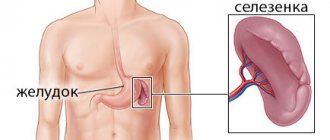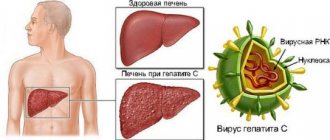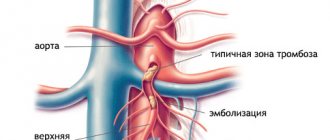Intestinal infarction is a disease in which blockage of the bloodstream of the mesentery occurs, and then, due to acute disruption of the blood supply, necrosis of the intestinal wall. The disease is also called thrombosis of visceral vessels, mesenteric infarction, intestinal ischemia. With a heart attack of the small intestine, pain occurs in the central region or right half of the abdomen, large intestine - in the left half, rectum - in the lower left.
Clinical classification of intestinal infarction
Depending on the severity of the disease, medicine classifies the disease into two types of course.
- Non-occlusive
. A milder form of the disease can be treated with medication without surgery. The blockage of blood vessels is incomplete, gangrene does not develop. Intestinal motility changes; serious consequences can occur only in the absence of treatment or in the wrong choice of treatment method. - Occlusal
. A very severe stage of the disease, the intestinal walls are completely cut off from the blood flow. The development of gangrene is inevitable; any delay in surgical intervention is fraught with death.
Classification in connection with the state of the circulatory system
Depending on the state of the circulatory system, intestinal infarction can have three stages of development of changes.
Table. Classification of intestinal infarction according to the state of the circulatory system.
| Stage name | Short description |
| The mildest stage of a heart attack, it is possible to restore physiological functions without any negative consequences. Patients may recover spontaneously and not be aware of the danger of their situation. Sometimes light conservative therapy is sufficient. Due to such mild consequences of this stage, medicine does not have accurate statistics; most cases are simply not recorded. | |
| As a result of a decrease in the volume of blood supplied to the intestinal tissue, a number of diseases can appear: ulcers on the walls, abdominal toad, colitis, enteritis. If treatment has not begun or does not correspond to the actual cause, then the patient’s condition will inevitably worsen, there may be bleeding due to micro-breaks of the small intestine, wall phlegmon, stenosis, etc. | |
| The last and most difficult stage of the disease. Gangrene and complete rupture of the intestines begin, purulent peritonitis and severe surgical sepsis spread. It is at this stage that patients most often end up on the operating table, but the likelihood of recovery is minimal. |
Who is at risk?
Due to the danger of developing the disease, as well as the complexity of diagnosis and duration of therapy, it is necessary to identify risk groups for the development of intestinal infarction. Patients included in it have diseases that, if left untreated, can lead to intestinal infarction. These include patients:
- With the presence of heart failure.
- Suffering from arterial hypertension.
- With identified atherosclerotic vascular lesions.
- With malformations of the cardiovascular system in the form of mitral stenosis or insufficiency.
- Those who have undergone surgery to replace the valve apparatus of the heart.
- With diseases of the hemostatic system in the form of hypercoagulation.
Recommended video:
Signs of intestinal infarction
The main symptom of intestinal infarction is pain syndromes. They have different intensities depending on the stage of development of the pathology.
- Ischemic stage
. The most severe pain, in intensity, can only be compared with a volvulus. Even today, medicine does not have effective means to eliminate such pain; even drugs do not help. The mute condition is alleviated by antispasmodics, but their effect is short-term and does not completely relieve the syndrome. The patient cannot restrain his screams, is very restless, pulls his legs to his stomach, panics and is afraid of death. The duration of this stage is from six to twelve hours. Upon external examination, severe pallor of the skin is noticeable; if patients have heart problems, then its cyanosis may increase. Due to the fact that the mesenteric artery is completely blocked, the pressure increases sharply, the jump reaches 80 mm Hg. Art. And this is against the backdrop of the fact that the pulse noticeably slows down. The leukocyte count increases to 12×109/l. The tongue becomes white, but the abdomen remains soft and there is no swelling. - Heart attack stage
. It begins immediately after the end of the acute pain stage and lasts 12–24 hours. Necrosis begins in the intestines, due to which the vital activity of pain receptors gradually ceases. This results in less pain. The patient rejoices, is in a stage of euphoria, it seems to him that all the troubles are behind him. Unfortunately, even inexperienced doctors often think that all problems have been solved and no special help is required anymore. Another feature is that intoxication of the body leads to inappropriate behavior of patients, they can laugh for no reason, increase activity, etc. The pressure returns to normal, the pulse returns to normal levels. The catastrophic development of the disease can be seen only on the basis of a general blood test. The number of leukocytes at this stage can reach 40×109/l. - Stage of peritonitis
. It occurs 18–36 hours after arterial occlusion, the pain gradually increases, the patient finds it difficult to move, and the condition worsens upon palpation. At this stage, the chances of survival are minimal, even urgent surgical measures have a 50% fatal outcome. If surgery is done later, the mortality rate is 100%. At this stage, endotoxemia and dehydration develop, and metabolic acidosis begins in the body. Patients become more mobile and enter a delirious state.
In the initial stages there is reflex vomiting; the presence of blood in the stool is important for making a diagnosis. As already mentioned, at the first stage of the disease the patient feels very severe pain, comparable to the symptoms of volvulus. But there is one difference. During a heart attack, intestinal patency is maintained; during volvulus, the evacuation function is absent. Moreover, the removal of feces can occur on an instinctive level; stool retention indicates that the disease has already reached the stage of peritonitis.
Symptoms of myocardial infarction
The classic form of myocardial infarction is accompanied by a severe pain syndrome of a compressive, tearing, burning nature. The pain is most often localized behind the sternum, but can also radiate to the left arm, left shoulder, lower jaw, and interscapular area. As a rule, the pain lasts more than 20 minutes and is not relieved by nitroglycerin within 5 minutes.
Other symptoms of classic myocardial infarction:
- increased sweating;
- psychomotor agitation;
- feeling of fear of death.
There are also atypical options for the development of myocardial infarction:
- abdominal form. In this case, the patient experiences heartburn, nausea, vomiting, pain in the upper abdomen;
- arrhythmic form. Characteristic signs are heart rhythm disturbances, a feeling of interruptions in the heart;
- asthmatic form. The main symptoms are shortness of breath, suffocation;
- painless form. It is characterized by the absence of pain or the presence of mild pain that occurs at varying frequencies. This form especially often develops in patients with diabetes mellitus and in people who have already suffered a myocardial infarction in the past.
Why is the painless form dangerous? First of all, the development of sudden cardiac death. In addition, if in the acute period a myocardial infarction occurs without clear clinical symptoms, then in the future this can lead to the development of chronic heart failure.
The painless form of myocardial infarction can be recognized by other signs. For example, a person may experience shortness of breath, increased fatigue, and exercise intolerance.
What causes a heart attack?
The reasons why intestinal infarction develops can be divided into three groups:
- thrombotic
- due to blockage of the mesenteric vessels by a thrombus (a blood clot that formed in some place and blocked the lumen of the vessel). More often the mesenteric arteries are clogged, less often the veins; - embolic
- due to blockage of the mesenteric vessels by any formations that were carried by the blood flow; - non-occlusive
- arising not due to blockage of the mesenteric vessels, but to their other pathological conditions.
The formation of blood clots that clog the mesenteric vessels can be caused by the following reasons:
- increased blood clotting (a number of diseases can lead to this);
- polycythemia (increased process of red blood cell formation due to increased proliferation of bone marrow);
- heart failure (almost any type of cardiovascular disease can lead to it);
- acute pancreatitis;
- intestinal injuries;
- intestinal tumors;
- taking hormonal contraceptives.
The following can act as emboli carried by the bloodstream and clogging blood vessels:
- detached blood clots – most often;
- air bubbles - for example, they can enter the bloodstream due to an incorrectly performed intravenous injection;
- accumulations of parasites;
- fragments of adipose tissue.
The following reasons can lead to the introduction of emboli that clog the mesenteric vessels:
- atrial fibrillation (chaotic contraction of heart muscle fibers, which also disrupts the normal flow of blood through the blood vessels);
- formation of wall blood clots during a heart attack (death of the heart muscle) and aortic aneurysm (protrusion of its wall);
- significant disorders of the blood coagulation system.
- In addition to blockage of the mesenteric vessels, non-obstructive causes can lead to deterioration of blood flow through them:
- deterioration of the heart, which causes the blood flow of the whole body to suffer – in particular, the blood supply to the intestines;
- spasm of mesenteric vessels;
- decrease in the amount of circulating blood - this can happen with various bleeding, dehydration, sepsis, massive burns, and so on;
- deterioration of general blood flow in various shock conditions.
In some cases, a combination of these factors may be detected.
Causes and risk factors
Typically, intestinal vascular ischemia occurs against the background of progression of cardiovascular pathology in people over 70 years of age. In older women, mesenteric infarction is twice as common. Taking into account the elderly age of patients and the presence of concomitant diseases, deciding on surgical treatment tactics can be quite difficult. The process of preparing for surgery is also delayed due to objective difficulties in making a diagnosis. Despite the optimization of diagnostic methods and therapy, mortality in cases of acute mesenteric infarction among patients reaches 50–90%.
Sometimes the onset of the disease is preceded by a period of precursors - the first signs of a developing heart attack, which patients often do not pay attention to or attribute them to indigestion.
Etiological factors leading to blockage of the bloodstream of the mesentery are divided into two groups:
- thrombotic or embolitic - blockage of the mouths of the mesenteric vessels with a thrombus or embolus that migrated from the proximal parts of the vascular bed. Mesenteric thrombosis can be caused by atherosclerosis, erythremia, myocardial infarction or endocarditis, hypercoagulation (increased blood clotting), atrial fibrillation, nonspecific aortoarteritis, prolonged blood stagnation, severe intestinal infection, purulent abscess, trauma;
- non-occlusive - deterioration of blood flow, decreased blood flow through the visceral vessels. The causes of this condition may be: arterial hypotension, mesenteric vasospasm, decreased cardiac ejection fraction, massive blood loss, congestive heart failure, dehydration.
Often, mesenteric infarction develops as a result of the simultaneous action of several causative factors.
The risk of developing the disease increases:
- old age (more than 60 years for women, 70 for men);
- sedentary lifestyle;
- prolonged dehydration;
- arrhythmias and other pathologies of the heart and blood vessels;
- heart surgery;
- myocardial infarction;
- cirrhosis of the liver (leads to increased pressure in the portal vein);
- chemotherapy.
What is the prognosis for intestinal infarction?
It is important to understand that this disease has a high mortality rate. It is higher than with a perforated ulcer and acute appendicitis. Because intestinal thrombosis often resembles other diseases that need to be treated surgically, it can be difficult to diagnose. The consequences of this may be irreversible. A healthy and young person does not need to be tested for existing mesenteric thrombosis. But those who fall into a certain risk group should be examined on a regular basis. This will help to identify pathology as early as possible.
Those who have a diseased heart or poor blood vessels should worry. It is necessary to donate blood for analysis periodically to detect the onset of increased thrombus formation. Anticoagulants will thin the blood, preventing blood clots from appearing. To avoid a recurrence of the situation, you should regularly undergo tests and take medications (vasodilators, prevent thrombosis, regulate blood clotting). If no action is taken, a severe intestinal infarction will develop, which can be fatal.
Diagnostics
As already mentioned, only a timely and correctly diagnosed disease gives the patient a chance to live. The count is not in days, but in hours; a lot depends on the qualifications of the doctor. But he must have access to modern medical equipment. What examination methods are considered the most appropriate?
- Angiographic examination
. Unfortunately, such examinations can only be performed by the most modern medical institutions. Contrast agents are injected into the blood, two projections are made, which makes it possible to see the actual condition of the mesenteric arteries. Pathology is detected regardless of the stage; the method is considered the most effective. - Laparoscopy
. A less effective, but more affordable method, many surgical hospitals have such equipment. Used before emergency surgical interventions. If the disease has progressed to the stage of gangrene, then there is a hemorrhagic effusion in the internal cavity, and fibrinous formations are clearly visible.
Manifestations of intestinal necrosis
The disease usually begins suddenly, and the nonspecificity of clinical signs does not allow all patients to make an accurate diagnosis at the initial stage. If the blood flow in the intestinal arteries has already been disrupted for some time against the background of atherosclerosis and periodic spasms, then discomfort in the abdomen is a familiar sensation for the patient. If pain appears against this background, the patient will not always immediately seek help, even if the pain is quite intense.
Symptoms of intestinal ischemia begin with abdominal pain - intense, in the form of contractions, which by the end of the first period of the disease becomes constant and severe. If the small intestine is affected, the pain is localized mainly near the navel; with ischemia of the colon (ascending, transverse, descending) - on the right or left in the abdomen. Complaints of nausea, stool instability, and vomiting are possible. The examination data does not correspond to the clinic, and with severe pain, the abdomen remains relaxed and soft, palpation does not cause increased pain.
Symptoms of intestinal infarction appear after the first period, approximately six hours after the cessation of blood circulation in the arteries or veins. At the same time, the pain intensifies, and symptoms of intoxication appear. In acute thrombosis or embolism, signs of necrosis develop rapidly, starting with intense pain in the abdomen.
The progression of intestinal gangrene and the addition of inflammation of the peritoneum (peritonitis) leads to a sharp deterioration in the patient’s condition:
- The skin is pale and dry, the tongue is covered with a white coating, dry;
- Severe anxiety appears, possibly psychomotor agitation, which is then replaced by apathy and the patient’s indifference to what is happening (areactive peritonitis);
- The pain weakens and may disappear completely, which is associated with total necrosis and death of nerve endings, and therefore this is considered an extremely unfavorable sign;
- The abdomen is initially soft, then gradually swells as intestinal atony worsens and peristalsis ceases.
The Kadjan-Mondor symptom will be specific for intestinal gangrene: when palpating the abdomen, a cylindrical formation of dense consistency is revealed, painful, difficult to displace. This is a fragment of the intestine with the mesentery, which has undergone edema.
A few hours after the onset of ischemia, fluid may appear in the abdomen (ascites); when inflammation occurs, they speak of ascites-peritonitis.
In case of a small intestinal infarction due to blockage of the superior mesenteric artery, vomiting mixed with blood and bile is among the symptoms. As it progresses, the contents of the stomach become fecal in nature.
Damage to the inferior mesenteric artery and gangrene of the thick section can manifest as blood in the stool, which is sometimes excreted copiously unchanged.
In the terminal stage of intestinal infarction, the patient's condition becomes critical. The pain weakens or stops completely, feces and gases do not pass away, intestinal obstruction develops, and severe intoxication is expressed, the patient is apathetic and indifferent, weak, does not show complaints not because of their absence, but due to the severity of the condition. Convulsions and coma are possible. Peritonitis begins 12-14 hours after the vessel is closed, death occurs within the first two days.
Even if you start treatment in the last stage of intestinal infarction, the effect is hardly possible. Irreversible changes in the abdominal cavity doom the patient to death.
Chronic intestinal ischemia may precede acute forms of damage. Its most common cause is atherosclerosis of the aorta, celiac trunk or mesenteric arteries, which provokes a lack of blood flow to the intestines.
Chronic intestinal ischemia is manifested by periodic cramping pain in the abdomen, which appears or intensifies after eating, which is why over time the patient begins to limit himself in nutrition and loses weight.
Impaired passage of contents through the intestines is accompanied by malabsorption, vitamin deficiency, and metabolic disorders. Patients complain of prolonged constipation, which is followed by diarrhea. Lack of blood flow causes a decrease in intestinal motor activity, stool stagnates - constipation occurs. Fermentation of feces provokes periodic diarrhea and bloating.
Low awareness of doctors in the field of identifying mesenteric thrombosis at the prehospital stage significantly affects the results of treatment, which is delayed due to the lack of a correct diagnosis. Another reason for late diagnosis may be the lack of technical capabilities in the hospital itself, because not everywhere there are conditions for urgent angiography, and not every hospital can even boast of having a working CT machine.
It is possible to suspect an infarction of the intestine by the presence of a compacted painful conglomerate in the abdomen, the presence of increased peristaltic sounds, or detection of areas of distended intestine by percussion by a characteristic ringing sound. Ultrasound, X-ray, angiography, and laparoscopy can be used to confirm the diagnosis.
How is the disease treated?
Treatment of mesenteric infarction must begin as quickly as possible; its timeliness determines the patient’s chances of survival and how serious the consequences will be. The goal of treatment is to eliminate the blockage of the vessel and remove the affected area of the intestine. In the first hours after the onset of a heart attack, it is necessary to begin thrombolytic therapy, which helps dissolve blood clots that have blocked the vessel. Medicines are used that activate fibrinolysis, i.e., the resorption of blood clots - streptokinase, streptodecase, urokinase and other anticoagulants.
At the same time, infusion therapy is started - intravenous infusion of drugs that stabilize blood circulation, replace the volume of circulating blood, and promote detoxification. In case of a heart attack caused by non-occlusive causes, the administration of antispasmodics is indicated to improve visceral blood flow. Attention! Photo of shocking content. To view, click on the link. The above methods relate to conservative therapy, and in this case, although they play an important, but auxiliary role.
In case of infarction of a section of the intestine, surgical intervention is required, and the less time passes from the start of drug therapy to surgery, the higher the chances of a favorable outcome. As the disease progresses, the patient's condition worsens, but at a certain point a period of imaginary well-being begins - the pain gradually weakens or disappears, but this is a poor prognostic sign. Surgical treatment consists of removing the affected area of the intestine, as well as restoring the blood supply to the affected area of the intestine. For peritonitis, the abdominal cavity is also rinsed with saline and antiseptics.
Acute disturbance of mesenteric circulation
Treatment of acute disorders of mesenteric circulation in the vast majority of cases involves emergency surgery, which should be undertaken as soon as the diagnosis is made or there is a reasonable suspicion of this disease.
The futility of using only conservative treatment methods has been proven by many years of practical experience. Only active surgical tactics provide a real chance of saving the lives of patients.
Surgical intervention should solve the following problems: 1) restoration of mesenteric blood flow; 2) removal of areas of the intestine that have undergone destruction; 3) fight against peritonitis. The nature and extent of surgical intervention in each specific case are determined by a number of factors: the mechanism of disturbance of mesenteric circulation, the stage of the disease, the localization and extent of intestinal lesions, the general condition of the patient, surgical equipment and the experience of the surgeon. The range of surgical procedures can vary from purely vascular surgery to purely resection interventions. In most cases, you have to combine both of these approaches. Restoring blood flow through the mesenteric arteries within 4-6 hours from the moment of occlusion (which is quite rare) usually leads to the prevention of intestinal gangrene and restoration of its functions. In case of irreversible changes in a more or less extended section of the intestine, in addition to its removal, surgery on the mesenteric vessels may still be necessary to restore the blood supply to its still viable sections.
The main stages of surgical intervention in this pathological condition should be considered: 1) surgical access, 2) inspection of the intestine and assessment of its viability, 3) inspection of the main mesenteric vessels, 4) restoration of mesenteric blood flow, 5) intestinal resection according to indications, 6) drainage and sanitation abdominal cavity. Let's take a closer look at each of them.
Surgical access should provide the possibility of revision of the entire intestine, exposure of the great vessels of the mesentery and retroperitoneal space, and sanitation of all parts of the abdominal cavity. A wide median laparotomy seems optimal.
Intestinal inspection necessarily precedes active surgical actions. The subsequent actions of the surgeon depend on the correct determination of the localization, extent and severity of ischemic intestinal damage. Detection of total gangrene of the small intestine forces us to limit ourselves to a trial laparotomy. The detection of ischemic disorders of the small and right half of the large intestine dictates the need for revision of the trunk of the superior mesenteric artery. The presence of necrotic changes in the sigmoid colon suggests exposure of the inferior mesenteric artery.
Assessment of intestinal viability is based on known clinical criteria: coloring of the intestinal wall, determination of peristalsis and pulsation of mesenteric vessels. This assessment in cases of obvious necrosis is quite simple. Determining the viability of an ischemic bowel is much more difficult. Mesenteric circulation disorders are characterized by a “mosaic pattern” of ischemic disorders: neighboring areas of the intestine may be in different circulatory conditions. That is why a repeated thorough examination of the intestine is often necessary after the vascular stage of surgery, and sometimes during relaparotomy one day after the first operation.
Revision of the main mesenteric vessels is the main distinguishing feature of surgical intervention in cases of suspected mesenteric circulation disorder. It begins with examination and palpation of the vessels near the intestine. Normally, pulsation is clearly visible to the eye. If mesenteric blood flow is impaired, pulsation along the edge of the intestine usually disappears. It is also difficult to detect it due to the developing swelling of the mesentery and intestinal wall. It is convenient to determine pulsation along the mesenteric edge by clasping the intestine with the thumb, index and middle fingers of both hands. To identify the pulsation of the mesenteric vessels located closer to its root, including the superior mesenteric artery, you should place one hand under the mesentery, and lightly squeeze it from above with the fingers of the other.
The pulsation of the trunk of the superior mesenteric artery is determined using the thumb and index fingers of the right hand. To do this, the thumb, feeling the pulsation of the aorta, is moved as high as possible to the site of the artery immediately to the right of the duodenum-jejunal flexure. By moving the small intestine to the right, you can determine the pulsation of the aorta and inferior mesenteric artery.
Sometimes (with swelling of the mesentery, systemic hypotension, severe obesity) it may be necessary to isolate the trunks of the mesenteric vessels. This is also necessary for intervention on them, aimed at restoring blood circulation in the intestines.
Exposure of the superior mesenteric artery can be done from two approaches: anterior and posterior. For embolism of the superior mesenteric artery, an anterior approach is usually used (Fig. 8.4). To do this, the transverse colon is brought into the wound and its mesentery is stretched. The mesentery of the small intestine is straightened, moving the intestinal loops to the left and down. The posterior layer of the parietal peritoneum is dissected longitudinally from the ligament of Treitz along the line connecting it to the ileocecal angle. The middle colic artery can be used as a guide, exposing it towards the mouth, gradually reaching the main arterial trunk. Depending on the location of the embolus, the artery is isolated either only in the area of origin of the middle colic artery (embolism of the first segment), or up to the bifurcation in the area of origin of the ileocolic artery (embolism of segments II and III).
With a posterior approach, the superior mesenteric artery is exposed to the left of the root of the mesentery of the small intestine. To do this, the intestinal loops are moved to the right and down. The ligament of Treitz is stretched and cut. The duodenojejunal flexure is mobilized. Next, the parietal peritoneum is dissected above the aorta. The left renal vein is located, above which the mouth of the superior mesenteric artery is located.
To isolate the inferior mesenteric artery, the parietal peritoneum is dissected longitudinally above the aorta. The trunk of the artery is found along the left lateral contour of the aorta.
Methods for restoring mesenteric blood flow depend on the nature of the vascular occlusion. Embolectomy from the superior mesenteric artery is usually performed from an anterior approach. After covering its trunk and mobilized branches using tourniquets, vascular scissors or a scalpel, a transverse arteriotomy is performed. It must be performed in such a way that, if necessary, catheter revision of the middle colon, ileocolic and at least one of the intestinal branches can be carried out through it. Embolectomy is performed using a Fogarty balloon catheter. The arteriotomy is sutured with separate sutures using a synthetic thread on an atraumatic needle. After bowel resection, embolectomy can also be performed through the stump of one of the transected branches of the superior mesenteric artery.
Vascular operations for arterial thrombosis are technically more difficult (thrombin-thymectomy, bypass surgery, and reimplantation of the artery into the aorta have to be performed) and give worse results. Due to the predominant localization of thrombosis in the first segment of the trunk of the superior mesenteric artery, a posterior approach to the vessel is indicated. The aorta is pressed parietally in the area of the artery mouth. It is opened with a longitudinal incision. Using instruments (vascular forceps, scissors, dissector), the thrombus is removed along with the intima. The distal edge of the intima is sutured with U-shaped sutures. The operation is completed by sewing a patch of autovein or synthetic material into the arteriotomy hole. Bypass operations are safer from the point of view of surgical risk. Rethrombosis of the superior mesenteric artery occurs less frequently after these interventions.
Prosthesis of the superior mesenteric artery is indicated when it has thrombosis over a significant extent. The graft can be sewn between the ends of the artery after resection of the area in the first segment or between the aorta and the distal end of the artery, and also connected to the right internal iliac artery. If thrombosis, which has developed against the background of a stenotic plaque, is localized at the mouth of the artery, replantation of the superior mesenteric artery into the aorta is justified.
Thrombectomy is indicated for thrombotic occlusion of the portal vein with transition to the superior mesenteric vein (descending thrombosis) or for occlusion of its trunk with an ascending nature of thrombosis. In this case, the operation is aimed mainly at preventing thrombosis of the portal vein. Thrombectomy can be performed through a longitudinal phlebotomy on the venous trunk or through a large intestinal branch after bowel resection.
Intestinal resection for disorders of mesenteric circulation can be used as an independent intervention or together with vascular operations. As an independent operation, resection is indicated for: thrombosis and embolism of the branches of the superior or inferior mesenteric arteries; venous thrombosis limited in extent; non-occlusive disorders of mesenteric blood flow. With the listed disorders, the extent of intestinal damage is, as a rule, insignificant, therefore, after resection, digestive disorders usually do not occur.
The predominance of high occlusions and late timing of surgical interventions in acute disorders of the mesenteric circulation quite often determine the use of subtotal resections of the small intestine. When performing resection for infarction, it is necessary to follow some technical rules. Along with the intestine affected by the infarction, it is necessary to remove the altered mesentery with thrombosed vessels, so it is not crossed along the edge of the intestine, but significantly away from it. In case of thrombosis of the branches of the superior mesenteric artery or vein, after incising the peritoneum 5-6 cm from the edge of the intestine, the vessels are isolated, crossed between clamps and ligated. For extensive resections with intersection of the trunk of the superior mesenteric artery or vein, a wedge-shaped resection of the mesentery is performed.
When resection is performed within viable tissue, an end-to-end anastomosis is performed according to the generally accepted technique. If there is a significant discrepancy in the diameters of the ends of the resected small intestine, a side-to-side anastomosis is formed. Recently, we have increasingly begun to resort to the practice of delayed anastomosis. The basis for such tactics are doubts about the exact determination of intestinal viability and the extremely serious condition of the patient during surgery. In such a situation, the operation is completed by suturing the stumps of the resected intestine and active nasointestinal drainage of the afferent part of the small intestine. After the patient’s condition has been stabilized against the background of intensive therapy (usually every other day), during relaparotomy the viability of the intestine in the resection area is finally assessed; if necessary, reresection is performed, and only after that an interintestinal anastomosis is applied.
When the cecum and ascending colon are affected, it is necessary to perform a right hemicolectomy along with resection of the small intestine. In this case, the operation is completed with ileotransversostomy.
Necrosis localized in the left half of the colon requires resection of the sigmoid colon (for thrombosis of the branches of the inferior mesenteric artery or non-occlusive disorder of the mesenteric circulation), or left-sided hemicolectomy (for occlusion of the trunk of the inferior mesenteric artery). Due to the serious condition of the patients and the high risk of failure of the primary colonic anastomosis, the operation, as a rule, should be completed with a colostomy.
If intestinal gangrene is detected, it is advisable to use the following procedure for surgical intervention. First, resection of clearly necrotic intestinal loops is performed with wedge-shaped excision of the mesentery, leaving areas of questionable viability. In this case, the operation on the vessels is delayed by 15-20 minutes, but the delay is compensated by the greater convenience of the operation, since swollen, non-viable intestinal loops make intervention on the mesenteric vessels difficult. In addition, this procedure of the operation prevents a sharp increase in endotoxemia after restoration of blood flow through the vessels of the mesentery and, to some extent, prevents the development of purulent peritonitis and possible phlegmon of the mesentery. The stumps of the resected intestine are sutured with UKL-type devices and placed in the abdominal cavity. Then intervention is performed on the vessels. After eliminating the vascular occlusion, it is possible to finally assess the viability of the remaining intestinal loops, and also decide on the need for additional intestinal resection and the possibility of anastomosis.
The rules for performing intestinal resection in cases where mesenteric blood flow is restored surgically are somewhat different (than without its restoration). Only obvious areas of intestinal gangrene are subject to removal; the resection boundary may be closer to necrotic tissue. In such a situation, the tactic of delayed anastomosis during relaparotomy is especially justified.
If, for one reason or another, surgery on the mesenteric vessels is not performed, intestinal resection must be performed within the area supplied by the vessel in which the occlusion occurred.
It is advisable to complete the intervention on the intestines with nasointestinal intubation, which is necessary to combat postoperative paresis and to carry out selective decontamination of the remaining part of the intestinal tract. This measure is a necessary component of relieving endotoxicosis.
Sanitation and drainage of the abdominal cavity should be carried out at the final stage of the operation. They are necessary as a measure to prevent purulent peritonitis or treat it if it has already developed. This procedure is performed in the same way as for other forms of secondary peritonitis. It is described in detail in Chapter XIII.
Intensive therapy. Improving the results of treatment of patients with acute disorders of mesenteric circulation largely depends on the effective provision of resuscitation measures in the pre- and postoperative periods, as well as adequate anesthesia during surgery.
Preoperative preparation includes a wide range of activities aimed at: (1) restoring the effective volume of circulating blood and improving tissue perfusion; (2) normalization of cardiac activity; (H) correction of metabolic disorders; (4)reduction of endotoxemia. The scope of preoperative preparation depends on the stage of the process, the presence and severity of concomitant diseases.
At the stage of intestinal ischemia and infarction, to prepare patients, measures aimed at reducing total peripheral resistance, replenishing the volume of circulating blood and combating metabolic disorders are used. Resuscitation measures for deep destructive changes in the intestine involving the peritoneum in the process do not differ from those for peritonitis of other etiologies (see Chapter XIII).
The rapidity of development of irreversible changes in the intestine is a factor dictating the need for emergency surgery and limiting the time of intensive therapy in the preoperative period (no more than 1-2 hours). Therapy must be continued during surgery. During surgery, close attention should be paid to adequate replacement of blood loss, especially after restoration of blood circulation in the intestine, which leads to massive hemorrhage into the wall and lumen of the intestine; to neutralize acidic metabolites washed out of the ischemic intestine.
In the postoperative period, intensive care includes measures aimed at improving systemic and tissue circulation, maintaining adequate gas exchange and oxygenation, correcting metabolic disorders, combating toxemia and bacteremia. It must be taken into account that resection of non-viable intestine does not eliminate severe systemic disorders, which may even worsen in the immediate postoperative period, including due to the loss of a significant part of the intestine, the role of which in the regulation of homeostasis is indisputable.
The main directions of therapy in the postoperative period can be formulated as follows.
1. Correction of hemodynamic disorders, maintaining an adequate volume of circulating blood, stabilizing cardiac output and improving the energy of myocardial contractions, normalizing tissue blood flow. Rheologically active agents and anticoagulants (rheopolyglucin, pentoxifylline, unfractionated or low molecular weight heparins) are of great importance in restoring effective blood circulation.
2. Normalization of gas exchange and ensuring adequate oxygenation, which in many cases can be achieved by using artificial ventilation.
3. Elimination of shifts in the water-electrolyte and acid-base state, which requires parenteral administration of an adequate amount of fluid, the use of buffer preparations, electrolytes and necessary microelements.
4. Replenishing the energy and metabolic needs of the body with the help of high-calorie infusions, amino acid and protein solutions. The patient should receive at least 4000 calories per day.
5. Prevention and treatment of acute renal and liver failure, which threaten many patients in the immediate postoperative period.
6. Treatment of intestinal paresis (long-term nasointestinal drainage, ubretide).
7. Rational use of antibacterial drugs.
With a favorable course, severe intoxication practically disappears by the 2-3rd day of the postoperative period. Hemodynamics stabilize, congestion in the stomach and thirst disappear, a feeling of hunger appears, peristalsis is restored, and gases begin to pass away. The well-being of patients noticeably improves after restoration of intestinal function. Leukocytosis gradually decreases and ESR decreases, the band shift disappears, the content of urea and bile pigments in the blood differs little from normal values. Diuresis is restored, proteinuria and cylindruria are reduced. In an uncomplicated postoperative period, these indicators are normalized by 7-10 days after surgery.
Low resistance of patients predisposes to the development of all kinds of complications (abdominal surgical sepsis, pneumonia, pulmonary embolism). These complications can be prevented by intensive therapy. At the same time, any conservative measures in case of relapse or progression of vascular occlusion are useless. That is why the main diagnostic efforts in the postoperative period should be aimed at identifying ongoing intestinal gangrene and peritonitis.
In patients with ongoing gangrene of the intestine, persistent leukocytosis and a pronounced band shift with a tendency to increase are observed, and the ESR increases. The development of jaundice and the progressive accumulation of nitrogenous wastes in the blood are perhaps the most characteristic signs of ongoing intestinal gangrene and indicate deep toxic damage to the liver and kidney parenchyma. Urine output progressively decreases to the point of anuria, despite large amounts of fluid administered and significant doses of diuretics. Urine examination reveals the development of toxic nephrosis, manifested in persistent and increasing proteinuria, cylindruria and microhematuria. Reasonable suspicions of ongoing intestinal gangrene serve as an indication for an immediate transition to active surgical actions - relaparotomy.
Early targeted (programmed) relaparotomy is performed to monitor the condition of the abdominal cavity when, after reconstructive vascular surgery, areas of intestine of questionable viability are left, or to perform a delayed anastomosis. The time for relaparotomy is from 24 to 48 hours.
Improving the results of treatment of acute disorders of mesenteric circulation primarily depends on the timely hospitalization of patients in surgical hospitals. Hospitalization should be carried out at the slightest suspicion of this disease. In the surgical department, the diagnosis must be confirmed or completely excluded within a few hours. Monitoring patients until signs of peritonitis appears is unacceptable. For diagnosis, instrumental methods (angiography, laparoscopy) should be used. As soon as the diagnosis is established, it is necessary to undertake emergency surgical intervention aimed at eliminating vascular occlusion and removing necrotic sections of the intestine. Based on our experience, we can state that only active diagnostic and treatment tactics can prevent an unfavorable outcome of this disease.









